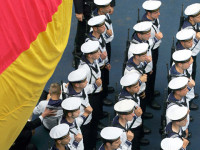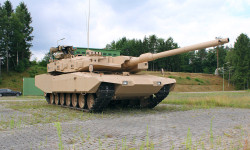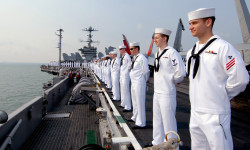Of the 25,000 marines, around 19,000 serve in the Navy itself, the others in the other parts of the Bundeswehr, mainly in the military base, the Central Medical Service and the Ministry. About 6,000 soldiers serve on sea-going units. In the Navy, in addition to professional and temporary soldiers, there are also volunteers who perform military service, but in considerably smaller numbers than in other areas of the Bundeswehr.
The rank designations in the Navy differ from those of the other branches of the Bundeswehr, but follow the same system. The crews and non-commissioned officers are specially trained in different ranges of use at schools of the navy and partly in other parts of the Bundeswehr. High-performing non-commissioned officers can be trained to become officers in military service and, in individual cases, officers in military service. All officers receive training at the Mürwik Naval School. With few exceptions, the officers of the military service receive studies at a university of the Bundeswehr.
Crews
- Matrose (Sailor)
- Gefreiter (private first class)
- Obergefreiter (upper private first class)
- Hauptgefreiter (main private first class)
- Stabsgefreiter (staff private first class)
- Oberstabsgefreiter (upper staff private first classes)
Matrose (Sailor)(1), Gefreiter (private first class)(2), Obergefreiter (upper private first class)(3), Hauptgefreiter (main private first class)(4), Stabsgefreiter (staff private first class)(5), Oberstabsgefreiter (upper staff private first classes)(6)
Noncommissioned officers without Portepee
- Maat (petty officer)
- Seekadett Offiziersanwärter (cadet officer candidate)
- Obermaat (senior mate)
Noncommissioned officers with Portepee
- Bootsmann (boatswain)
- Fähnrich zur See Offiziersanwärter (Sergeant to the sea officer cadet)
- Oberbootsmann (Upper boatswain)
- Hauptbootsmann (Main boatswain)
- Oberfähnrich zur See Offiziersanwärter (Upper officer cadet to the sea officer cadet)
- Stabsbootsmann (Stick boatswain)
- Oberstabsbootsmann (Upper stick boatswain)
Maat (petty officer) (1), Seekadett Offiziersanwärter (cadet officer candidate) (2), Obermaat (senior mate) (3), Bootsmann (boatswain) (4), Fähnrich zur See Offiziersanwärter (Sergeant to the sea officer cadet) (5), Oberbootsmann (Upper boatswain) (6), Hauptbootsmann (Main boatswain) (7), Oberfähnrich zur See Offiziersanwärter (Upper officer cadet to the sea officer cadet) (8), Stabsbootsmann (Stick boatswain) (9), Oberstabsbootsmann (Upper stick boatswain) (10)
Officers (except medical officers)
Leutnante (Second lieutenants)
- Leutnant zur See (Second lieutenant to sea)
- Oberleutnant zur See (first lieutenant to sea)
Hauptleute (Main people)
- Kapitänleutnant (Captain second lieutenant)
- Stabskapitänleutnant (staff captain second lieutenant)
Stabsoffiziere (Staff officers)
- Korvettenkapitän (Lieutenant commander)
- Fregattenkapitän (commander)
- Kapitän zur See (captain to sea)
Generale (Admirale, Flaggoffiziere) (Generals (admirals, flying a flag officers))
- Flottillenadmiral (Flotilla admiral)
- Konteradmiral (countering admiral)
- Vizeadmiral (Vice Admiral)
- Admiral (admiral)
Leutnant zur See (Second lieutenant to sea)(1), Oberleutnant zur See (first lieutenant to sea)(2), Kapitänleutnant (Captain second lieutenant)(3), Stabskapitänleutnant (staff captain second lieutenant)(4), Korvettenkapitän (Lieutenant commander)(5), Fregattenkapitän (commander)(6), Kapitän zur See (captain to sea)(7), Flottillenadmiral (Flotilla admiral)(8), Konteradmiral (countering admiral)(9), Vizeadmiral (Vice Admiral)(10), Admiral (admiral)(11)
Medical officers
Hauptleute (Main people)
- Stabsarzt (captain in the medical corps)
Stabsoffiziere (Staff officers)
- Oberstabsarzt (Upper medical officer)
- Flottillenarzt (flotilla physician)
- Flottenarzt (fleet physician)
Generale (Admirale, Flaggoffiziere) (Generals (admirals, flying a flag officers))
- Admiralarzt (Admiral physician)
- Admiralstabsarzt (admiral medical officer)
- Admiraloberstabsarzt (admiral upper medical officer)
Stabsarzt (Medical officer)(1), Oberstabsarzt (Upper medical officer)(2), Flottillenarzt (flotilla physician)(3), Flottenarzt (fleet physician)(4), Admiralarzt (Admiral physician)(5), Admiralstabsarzt (admiral medical officer)(6), Admiraloberstabsarzt (admiral upper medical officer)(7)
You can find the right literature here:
The German and the Austrian Navies: Second Edition Volume 1
This is the second edition of "The German and the Austrian Navies" - Volume One by self-published author Marc E. Nonnenkamp. A full time royalty accountant and auditor for US federal crude oil, natural gas and coal royalties has written about one of his favorite subjects - this is a unique and comprehensive literary catalog history of named vessels which have served in the German-speaking Navies of the world. The author's paternal grandfather served in the interwar German "Reichsmarine" from 1924-1936 and his late cousin Gerd Nonnenkamp served in the postwar "Bundesmarine" during the 1960s and 1970s. The first edition of Volume One featured 36 Black & White Illustrations, whereas this second edition of Volume One has 153 mostly color illustrations (where the original illustration was in color) - hence the higher retail price which was set by the publishing company and not by the author. Students of German and Austrian Naval history will appreciate the book's detail and depth. Battleships, Battlecruisers, Dreadnoughts, Pre-Dreadnoughts, Armored Coastal Ships, Casemate Ships, Heavy Cruisers, Armored Cruisers, Armored Frigates, Sailing Frigates, Light Cruisers, Small Cruisers, Armored Corvettes, Sailing Corvettes, Brigs, Galiots, Batteries, Schooners, Sloops, smaller sailing vessels and Wooden Sailing Ships - they're all here. This is Marc E. Nonnenkamp's 4th book on the subject of the German-speaking Navies of Germany, Austria, Austria-Hungary, Venice, the Holy Roman Empire, the Hanseatic League Cities, West Germany and even the former East Germany. These books have been read by more than 71,000 Naval history buffs from 187 countries on 6 continents. The first editions of the author's 2 Volume work received a good review written by Walter "Winn" Price of the US Naval Historical Foundation in Washington, D.C. and have received over 15,000 "Likes" and "Shares" on their website. In addition to being endorsed by the US Navy, Marc E. Nonnenkamp's books are also endorsed by the US Army - California National Guard. The author served in the US Naval Sea Cadet Corps at the former Alameda Naval Air Station from 1974-1978 in both the USS Midway and USS Hancock Squadrons.
The German and the Austrian Navies - Volume 2: Second Edition
Marc E. Nonnenkamp has published five (5) books about the German-speaking navies of the world, the four (4) most recent books through CreateSpace in a first and a second edition of a two-volume series. The first edition of the series was released in 2011 and this new second edition has been published in 2015. The books have been read by more than 72,000 people from 187 countries on all 6 inhabited continents. The first edition featured 60 black & white illustrations in two volumes, whereas the second edition has 270 color illustrations (where the original illustrations were made in color). German-speaking navies have come from Germany, Austria and from former political entities such as West Germany (1949-1990), East Germany (1949-1990), Austria-Hungary (1867-1918), Austria-Venice, the North German Federation (1867-1871), Brandenburg-Prussia, the Holy Roman Empire of the German Nation (800-1806) and from the Cities of the Hanseatic League. These countries built no fewer than 64,837 vessels from the Middle Ages until today. The expansive work written by Marc E. Nonnenkamp is primarily about the more important vessels to have been commissioned with names, and not merely with call or pennant numbers. The ship indices following Volumes One and Two of the Second Edition include the names of 1,877 such vessels - 911 in Volume Number One and 966 in Volume Number Two. All major and minor ship classes are found here, ranging from battleships and planned aircraft carriers to cruisers, destroyers, frigates, corvettes, torpedo boats, fast attack craft, patrol boats, tugboats, landing craft, tenders, sloops, brigs, depot ships, hospital ships and submarines. Volume Two also features an interesting section about the brilliant (but not implemented) Mediterranean strategy of the German Navy during World War Two - a strategy designed by both Grand Admiral Erich Raeder (Commander in Chief of the German Navy from 1928 until Hitler fired him in 1943) and General Field Marshall Erwin Rommel - the gifted commander of armored and mechanized troops who led many of Germany's early World War Two triumphs in France and in North Africa, where he led the famed "Afrika Korps" of German and Italian soldiers. Erwin Rommel was part of the failed attempt on Hitler's life on July 20, 1944 and was coerced into committing suicide by members of the Gestapo (State Secret Police) later in 1944. Instead of following the advice of both Raeder and Rommel, Hitler chose to make the greatest blunder of his political and military career - the June 22, 1941 invasion of Russia ("Operation Barbarossa") which would cost Germany the Second World War in the ruins of the Prussian-German Capital City of Berlin by May of 1945. Marc E. Nonnenkamp's paternal grandfather Wilhelm Johannes Nonnenkamp served in the Reichsmarine of the Weimar Republic from 1924 until 1936 aboard ships including the Pre-Dreadnought Battleship "Braunschweig," the Training Ship "Bremen" and the original Pocket Battleship "Deutschland." His late cousin Gerd Nonnenkamp served in the postwar West German Bundemarine aboard the Destroyer "Hamburg." His grand uncle Erich Rudolph served aboard a German submarine during World War Two, being among the 25 percent of German submariners who made it back home to Germany after the war.
The Three German Navies: Dissolution, Transition, and New Beginnings, 1945-1960

The Three German Navies: Dissolution, Transition, and New Beginnings, 1945-1960 (New Perspectives on Maritime History and Nautical Archaeology) Hardcover – December 14, 2002
A comparative study of the dissolution, transition, and new foundation of naval forces in Germany after World War II, this book examines how postwar experiences such as captivity, war crimes prosecution, and the de-nazification process set the parameters for establishing the East and West German navies.
Douglas Peifer refutes previous interpretations that the end of the Third Reich in 1945 and German admission into NATO and the Warsaw Pact in 1955-56 marked complete breaks in German military history. By shifting the focus from Washington, London, and Moscow to Bremerhaven, Hamburg, and Rostock, he provides a corrective, experiential view of Germany's rearmament and remilitarization. Peifer's comparative approach, which pits East against West and the Kriegsmarine against the two postwar navies, makes this book a first in the field of maritime history.
Using primary archival material and interviews with some of the founding figures of the East and West German navies, Peifer tells clearly the complicated story of the numerous decentralized and often parallel agencies operating under Soviet and Western supervision. These semi-official units took up navy-like functions in the late 1940s: disposal of mines, supervision of maritime borders, fishery protection, and eventually espionage and counterespionage. Covering an 11-year period, Peifer shows how the United States, Great Britain, and the Soviet Union shifted tactics from dismantling the vestiges of the Kriegsmarine to sponsoring new German naval organizations, how the process differed in the two new Germanies, and to what extent Kriegsmarine veterans and concepts shaped the new naval forces.
Quieter, Deeper, Faster: Innovations in German Submarine Construction
German submarine technologies count among the leaders in the world. The Germans were not the first to have introduced submarines into their navy, but it wasn’t long before the most technically demanding boats were being designed and built in german shipyards – a pursuit which has always involved ground breaking innovations and continues to this day. The compilation ranges from the first diving boats around the turn of the century to the modern HDW class 212A and 214 of ThyssenKrupp Marine Systems, to tomorrow's submarine technologies as well as the HDW class 210mod and 216—still only existing on paper. The author explains different mission profiles of current submarines and also adds a list of all submarines built in Germany after 1945. The extensive documentation is completed by 130 illustrations—including many impressive pictures of the renowned photographer Peter Neumann.
This post is also available in:
 Deutsch (German)
Deutsch (German)  Français (French)
Français (French)  Italiano (Italian)
Italiano (Italian)  简体中文 (Chinese (Simplified))
简体中文 (Chinese (Simplified))  Русский (Russian)
Русский (Russian)  Español (Spanish)
Español (Spanish)  العربية (Arabic)
العربية (Arabic)





















